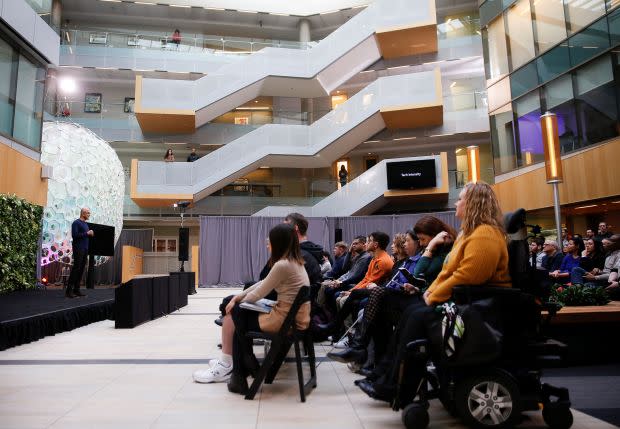Neurodiverse applicants are revolutionizing the hiring process

When Jesse Collins applied to work as a quality assurance tester at JPMorgan Chase in 2018, he felt a lot of the same things many of us feel: slight imposter syndrome about not having the same qualifications as other applicants, and apprehension about the social rules governing the experience. But those feelings are a bit more intense for someone who has autism, as Collins does. “In general, in social situations, I’m not like ‘yay,'” he tells Quartz.
Fortunately for Collins, the company’s Autism at Work program meant he had a different interview process than he might have had otherwise. He, along with a number of other applicants, spent a week honing the skills he’d need in his job and talking with hiring managers from JPMorgan and other companies. It was like a weeklong interview, he says, and definitely less intense than if he’d just walked into the company’s offices. “I appreciate they acknowledged my skill set and were curious about my natural abilities in this type of work,” Collins says. It was also liberating for him to be in a room of neurodiverse people—which includes those on the autism spectrum, with dyslexia, or with attention deficit hyperactivity disorder (ADHD)—for the first time. “Our minds worked similarly but differently, our minds complemented each other,” he says.
Collins, who now works in performance testing, is one of 220 neurodiverse employees JPMorgan has hired since the program started in 2015. It’s one of several organizations seeking job candidates who are neurodiverse.
Many neurodiverse people struggle to get hired, or, once hired, to fit in with social or unwritten cultural aspects of the workplace. But they bring subject-matter expertise and a skill set companies are starting to see as an advantage. As corporations and organizations have become more aware of the value that neurodiverse individuals can add, they’ve devised new and inspired programs to help them get and stay hired. The resulting trend is already benefitting not only neurodiverse workers, but all employees with disabilities, and improving company culture in the process.
Harnessing talent
One in four American adults lives with a disability. Though just over 2% of US adults have autism, they have disproportionately struggled to find work. A 2015 report (pdf) found that people with autism had lower employment rates than people with other kinds of disabilities.
But about six years ago, the conversation started to change, says Susanne Marie Bruyere, a professor of disability studies at Cornell University. Companies looking to hire for technical roles in cybersecurity, coding, and debugging were struggling to find talent, Bruyere says; when leaders in the Israeli army developed a program to use autistic people’s talents in technical and detail-oriented roles, companies began to realize the value of this untapped talent pool. Soon, organizations such as software company SAP, tech company Hewlett Packard, consulting firm Ernst & Young, and many others developed programs of their own. Almost all of them design and kick off their programs with help from diversity and inclusion personnel, and a volunteer committee of existing staffers on the spectrum, parents of children with autism, and other stakeholders.
It’s not just business, either. In Dec. 2020, the US National Geospatial Intelligence Agency (NGA) launched a neurodiversity pilot program, the first of its kind at a government agency. It’s looking to hire a cohort of four employees and onboard them by sometime in May, says Michael Hales, who has been spearheading the initiative.
“I’ve been in this field for a long time and I’ve never seen companies so enthusiastically and energetically trying to make something work,” Bruyere says.
Best practices for neurodiverse hires
Though the specifics of each company’s program varies depending on the roles they’re hiring into and the company’s culture, some best practices emerge.
One is to tailor the interview process. Microsoft considers other ways to evaluate potential hires’ skills. Four times a year, the company offers a four-day, cohort-based event for potential hires. The first two days are activities, such as Lego Mindstorms, that allow candidates to showcase their skills, says Neil Barnett, Microsoft’s director of inclusive hiring and accessibility. Candidates meet one another, as well as the hiring managers. The third day is spent on mock interviews and sprucing up candidates’ online job profiles. The actual interview is on the fourth day: “It’s the same kind of interviews you’d have at Microsoft for any other role, but they’re more spaced out so [candidates] have more time in between,” Barnett says. About half the candidates will land a job; the others will get feedback designed to help them get hired in the future, either by Microsoft or elsewhere. The company has hired 100 people this way since 2016, Barnett says.
JPMorgan is all about accommodations for potential new hires. “We’ll give them a Google Map to where they’ll be, a picture of the person or people they’ll meet with so they’re familiar before walking in,” says Anthony Pacilio, vice president and global head of Autism at Work. “They can bring an advocate—a spouse, parent, job coach. We’ll walk them through the environment…we’ll make any accommodations we can make for an interview, like smaller or larger room, a dimly lit room, providing noise cancelling headsets if it’s too loud,” he says. There are interviews, but they’re only about 30 minutes each, and hiring managers don’t ask open-ended, interview staple questions like “Where do you see yourself in five years?” as they are more likely to be misinterpreted.
Retention and support
Collins has found the environment at JPMorgan to be a game changer. “Being supported when you have autism, it’s nice—nice is an understatement,” he says. “I didn’t realize how important it would be. Now having it, I could never work somewhere that doesn’t have it.”

Jesse Collins
Companies quickly realized it wasn’t enough to get neurodiverse employees in the door. “Really early on, within the first year or two, people moved from ‘Where do we find the talent?’ to ‘How do we keep the talent?'” Bruyere says. “[Neurodiverse hires] wanted to advance in the organization, they wanted to know how to do that…Companies realized they had to think more holistically about the whole employment process.”
Once someone is hired, it’s important they feel connected to their workplace. Both JPMorgan and Microsoft offer these hires support circles consisting of a job coach, a buddy or community mentor to help employees navigate company culture, as well as the larger neurodiverse community—either a formal cohort or simply folks who were previously hired through the program.
Companies also train managers about how to best work with neurodiverse employees. At JPMorgan, that training involves education defining neurodiversity and autism, best practices about how to manage neurodiverse employees, and how to do typical managerial tasks like performance reviews. It’s a three-hour training for managers and a one-hour training for colleagues, which has been labor-intensive to roll out across the company (Pacilio says 6,000 of JPMorgan’s 250,000 employees have been trained so far). But it’s worth it: “Making the person on the spectrum successful lies within that manager,” Pacilio says.
That cultural shift is what NGA, the government agency, is hoping to achieve, too. “What we’re doing is not a separate program. We’re learning a lot about how to help our agency be more inclusive and help our persons with disabilities program be better equipped to onboard people with autism, and take care of and support the people with autism we already have on staff,” Hales says. “It’s helping us go after hiring world-class talent. We believe people on the autism spectrum are part of that.”
Is it working?
The rethinking of practices, the trainings—it all takes time and resources. So how do companies know it’s worth it? “Everyone wants metrics” about the impact of JPMorgan Chase’s program, Pacilio says. He can rattle off some impressive ones: that employees hired through the neurodiversity programs into certain tech roles are 90% to 140% more productive than employees who had been there five or 10 years; that the new hires clear all the work in their queue with zero errors; that on the business side, they’re doing the work of two people.
But Bruyere says to be careful about what we glean from these numbers. Neurodiverse employees don’t have super powers. Rather, she said, it’s the result of careful job matching, employees’ natural strengths, managers who help them use them, and organizations to support them.
Still, the program’s success has had an outsized effect at each company, even for folks who don’t interact with neurodiverse employees. “The culture has shifted at Microsoft to be even more inclusive…I know it’s working because I see the tremendous talent we bring into these cohorts. Managers saying this is great talent for my team. I see the talent come in and thrive at the company,” Barnett says.
Such programs are expanding, both within these organizations and beyond. At JPMorgan, the Autism at Work team plans to expand trainings to anyone in the company. Through the consortium, of which JPMorgan and Microsoft are both members, companies share best practices and help other organizations start their own programs. Some multinational organizations, Bruyere said, are figuring out how to scale these programs internationally.
At NGA, the pilot will end in May, but Hales hopes its impacts will last far beyond. “The goal at the end of the day is to normalize these processes as part of our persons with disabilities program. By learning from it and how to do it better, I think it will expand naturally.”
In the future, Pacilio hopes there will be no need for a role like his. “I shouldn’t have this job in five or 10 years—it should be built into the DNA of what every company does,” he says. “It’s all about finding that untapped talent in those different pockets that will make your organization culturally better. The productivity is a given depending on the job function. Plus, it’s just the right thing to do.”
Sign up for the Quartz Daily Brief, our free daily newsletter with the world’s most important and interesting news.
More stories from Quartz: